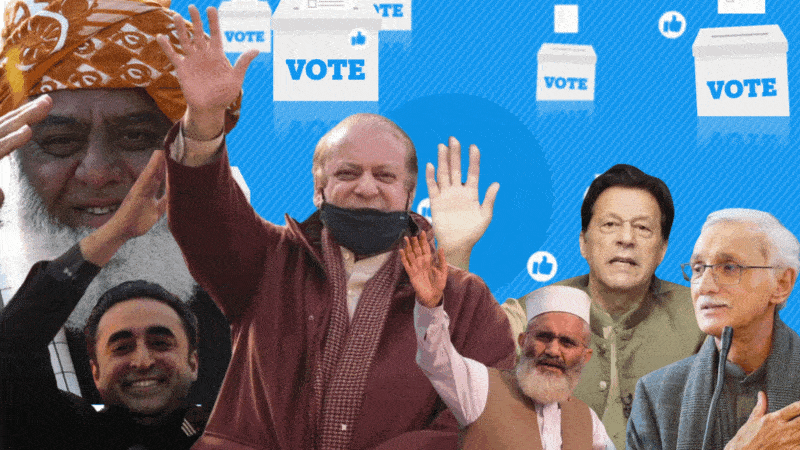In the five-year marriage of the ‘hukamraan’ and the ‘awaam’, manifestos are the wedding vows.
With just two days to go for the February 8 general elections, mainstream political parties have finally unveiled their rather ambitious election manifestos — a list of mostly empty promises.
An election manifesto is a list of policies that a political party vows to enact if it is voted into office. To put it simply, in the five-year marriage of the ‘hukamraan’ and the ‘awaam’, manifestos are the wedding vows.
If crafted smartly, they can bridge the gap between political parties and voters, particularly young ones who comprise over 45 per cent of the total registered voters in the country.
Unfortunately, in Pakistan, election manifestos have become more of a strict ritual than a meaningful exercise.
According to Pakistan Institute of Legislative Development And Transparency (Pildat) President Ahmed Bilal Mehmood, political parties feel that a large segment of voters do not bother much about reading election manifestos to make up their mind on voting or not voting for a party.
“They may have been right until a few elections ago when a growing middle class, the rise of social media and the youth bulge in the voters’ list started changing poll dynamics. At least an emerging class of voters is no longer content with the traditional politics of slogans, tall promises, opponent-bashing and communicating with voters on issues only during elections. Voters demand greater engagement,” he writes in an op-ed for Dawn.
It is not surprising that major political parties including the PML-N, PPP and PTI only recently unveiled their manifesto, a few days before the elections. And, as usual, they lack an action plan.
Therefore, before you pronounce ‘I do’ on Feb 8, Dawn.com takes a look at and analyses the plausibility of some of the ‘will dos’ and ‘won’t dos’ promised.
‘Will bring inflation down to 6pc’
After multiple delays, the PML-N, which has been dubbed the ‘king’s party’ this year, unveiled its election manifesto on January 27. Among several other promises, the party, without going into detail, vowed to introduce a series of measures to bring down the inflation rate to 6pc.
The Nawaz Sharif-led party described its policy document as the culmination of three-month-long efforts by over 30 committees.
According to data released by the Pakistan Bureau of Statistics, the inflation rate — measured by the Consumer Price Index (CPI) — for January clocked in at 28.34pc year-on-year. During its Monetary Policy Committee meeting earlier this week, the State Bank of Pakistan also raised the average inflation forecast for the fiscal year ending in June to 23-25pc from a previous projection of 20-22pc, due to rising gas and electricity prices.
Taking inflation down over four times looks like an uphill task for Nawaz Sharif. But macroeconomist Sajid Amin Javed says it is doable.
If the PML-N emerges victorious in the forthcoming polls and manages to form a government, it may be able to bring inflation down to 6pc by the end of its term in 2027, he told Dawn.com.
Amin said that if the rupee is artificially overvalued — a job former finance minister and Nawaz’s close aide Ishaq Dar knows well — it could slow down inflation, but warned that has its own set of disadvantages.
Another way the economist sees inflation coming down is through the base price effect when a larger change in absolute prices — that affects purchasing power — shows a smaller percentage as the base price.
‘Will create 10m jobs’
Another pledge that Nawaz made in his manifesto was to bring the unemployment rate to 5pc by creating at least 10 million jobs during his five years in power.
A similar promise was previously made by incarcerated former prime minister Imran Khan, who headed the PTI government from 2018 to 2022, but his vows did not materialise.
Most of us may be used to it now, but it is best to prepare for yet another disappointment.
In June last year, just a month before the Shehbaz Sharif-led Pakistan Democratic Movement’s government dissolved the National Assembly, it had approved an estimated 3.5pc GDP growth target for its 2023-24 financial year budget.
But despite an improved global outlook and a $3 billion standby agreement, the International Monetary Fund (IMF) last month lowered Pakistan’s economic growth forecast to 2pc for the current fiscal year. The Washington-based global lender also slightly revised downward (by 0.1pc) the next fiscal year’s growth forecast to 3.5pc.
While the IMF’s growth forecast was significantly lower than the government’s GDP growth target for the current year, it was generally in line with the State Bank of Pakistan’s expectation of 2pc to 3pc as part of the monetary policy statement.
Keeping in view these expectations, it is a very difficult task for the PML-N, or any other party as a matter of fact, to create 10m jobs. Amin says the GDP growth rate needs to be between 6pc and 7pc to achieve the target, which is almost impossible in the current scenario.
The macroeconomist further lamented that including the PML-N, none of the parties had given an action plan along with their manifestos, which he stressed was the most important.
“Will they go to the IMF or not? What will be done with the debt repayments? These are all questions that need to be answered,” Amin added.
‘Will reduce electricity prices’
Several mainstream political parties, including the PML-N, PPP and Jamaat-i-Islami, have also focused on bringing down electricity prices.
Last year, Pakistan saw massive nationwide protests as inflation-weary citizens took to the streets to vent their anger against inflated bills.
The demonstrations began after Nepra, the federal authority that sets electricity prices for all power consumers, announced a revised electricity tariff. The tariff for residential consumers — which is the same for consumers all over the country — was increased by as much as Rs7.50 per unit, or 27 per cent.
But what caused the increase? Very simply, the electricity tariff rose sharply due to the PDM government’s failure to adequately manage the financial crisis and the country no longer had enough to continue subsidising electricity for most consumers.
The protests forced the caretakers to launch a crackdown against electricity theft, which they blamed for the exorbitant prices, and a bunch of other measures.
Therefore, it is no surprise that mainstream political parties such as the PML-N, PPP, and JI used lower electricity prices as one of their pledges.
It must be noted that Pakistan’s power generation heavily relies on conventional energy sources (eg imported fossil fuels), which are vulnerable to international market price volatility and foreign exchange rates, resulting in a high cost of electricity generation.
Economist Amin says cheap electricity is only possible when the government prioritises green energy and other alternatives. A good example is solar energy. If financed by the government, it is possible for the government to fulfil this promise, he says.
Meanwhile, Muhammad Sohail, chief executive of Karachi-based brokerage firm Topline Securities, is of the opinion that electricity prices could only be reduced by countering theft and improving collections.
“Along with that, the demand for electricity needs to increase to reduce the impact of capacity purchase price that may help bring down the rates,” he added.
At the same time, commenting on the pledges of providing free units of electricity, Amin told Dawn.com that they were merely “political slogans”.
‘Will construct 3m houses across Pakistan’
Enter former foreign minister and PPP Chairman Bilawal Bhutto-Zardari. The Bhutto scion has been touring the country on his election campaign, which has been a cocktail of not-so-subtle jibes at long-time rival PML-N, discreet sympathy for the PTI and a long list of vows, each cunningly crafted to woo the awaam.
But among several other promises Bilawal has made in recent days (we will come to those later), one that has caught attention is the one where he says he would build three million houses.
At the launch of the ‘Awami Muashi Muahida’, or the People’s Charter, last month, the PPP chairman vowed to build at least three million homes.
Ex-PM Imran Khan had also made a similar promise of constructing five million houses across the country, which was also left unfulfilled. For Bilawal, a similar fate awaits in the near future.
Let’s remind Bilawal that there are several families back in Sindh, who lost all they owned to the devastating floods of 2022. Many of them are still homeless and waiting for the government to fulfill its promises. Some languish in Karachi’s slums while others live under the open sky.
And what about the tens of thousands of people in Karachi, who have been living amid the rubble of their homes following the anti-encroachment drive to clear the city’s drains in Manzoor Colony, Orangi, and Gujjar nullahs? Or the residents of Mujahid Colony, who have been living in makeshift tents for over a year now?
Wouldn’t it be better to first house these people and then make new promises?
‘Will criminalise enforced disappearances’
When he launched his election campaign towards the end of last year, Bilawal chose Balochistan as the province to kick off electioneering. During the rally, where he was accompanied by his father and former president Asif Ali Zardari, the Bhutto scion repeatedly emphasised how he “understood the pain of the Baloch people”.
His statement had come at the perfect time: hundreds of Baloch men and women were protesting outside Islamabad’s National Press Club in the freezing cold. They were demonstrating against enforced disappearances.
At a recent rally in Khuzdar, Bilawal expressed his displeasure and disappointment at the treatment meted out to the Baloch protesters, and vowed to find a solution to the problem of missing persons. But can he do that?
Author and journalist Zahid Hussain calls the pledge a tall claim by Bilawal.
“Given the predominance of security in the country’s power structure, it will not be possible for a civilian government to hold intelligence agencies for forced disappearances,” he told Dawn.com.
“We have seen such tall claims in the past by the main political parties but nothing happened under their tenure,” Hussain said, adding that there was a need for a broad agreement among political parties to resolve the issue.
‘Will bring legislation to directly elect prime minister’
Meanwhile, the PTI, which has fallen from grace post-May but refuses to give up, has avoided making too many outlandish commitments — primarily because its populist leader Imran remains incarcerated. It would have been an entirely different ball game if the kaptaan was still on the pitch.
But one of the things that the party proposes in its election manifesto, which can only be accessed using a VPN, is a “shift towards a more inclusive, representative parliamentary democracy” including constitutional amendments for direct election of prime minister, reducing the tenure of National Assembly to four years and Senate’s to five years.
“The prime minister, under our plan, will directly be elected, reducing the influence of vested interests and enabling the selection of individuals best suited for their roles.
“This prime minister will form a cabinet consisting of up to 10 advisors and 15 experts chosen from the National Assembly, ensuring that qualified individuals are in the right positions to drive the nation forward,” the party’s election manifesto says.
However, Dawn’s Islamabad bureau chief Amir Wasim said that no matter what the PTI writes in their manifesto, the reality is that the party would not have any representation in the incoming National Assembly.
According to the rules, he explained, independent candidates have three days to join a party that has representation in the NA after the results of the general elections are announced.
“After the deadline, they would remain independent. They could form a group of their own and would have their say in the parliament but would not be counted as representatives of the PTI,” he said.
A similar situation persisted during the Senate elections in 2018, when PML-N leaders were elected senators as independents. “PML-N still exists today, but technically, these senators are retiring this year as independents,” the journalist highlighted.
Wasim stated that to bring the changes that it wants, the PTI would need a two-third majority as the same would require a constitutional amendment. But that cannot be done alone by any political party.
‘Will fulfil the promise of Naya Pakistan’
The promise of ‘Naya Pakistan’ has followed the people into 2024.
Just days before the general elections in 2018, Imran Khan had unveiled his party’s manifesto that carried an elaborate plan to transform the country into ‘Naya Pakistan’ — a term that doubled as his party’s slogan through their successful campaign and beyond.
While the PTI-led government launched several projects for the fulfillment of some of its promises under the slogan, the progress on these pledges remained stuck and, in some cases, was also marred with delays. Subsequently, in the coming days, rival parties fired broadsides at the PTI for making empty claims.
On the fateful night of April 9, 2022 — the day Imran was successfully booted from power — Bilawal had proudly proclaimed: “Welcome back to Purana Pakistan.”
Two years later, the promise of ‘Naya Pakistan’ has resurfaced yet again. Istehkam-i-Pakistan (IPP), a faction of the PTI that emerged following the May 9 chaos, has vowed to take up what was abandoned midway.
Launching his party’s election campaign last year, Imran’s friend-turned-foe and IPP patron-in-chief Jahangir Khan Tarin has pledged to “truly bring about ‘Naya Pakistan’.
But with a team more or less similar to Imran’s, will Tareen be able to fulfil the promise? In the current scenario, it hardly seems possible.
In the run-up to the upcoming polls, the IPP finds itself wrestling with its own set of challenges and is grappling with an identity crisis. The party is gingerly navigating the treacherous waters of political alliances and seat adjustments, often finding itself in the shadow of the larger and more entrenched PML-N.
As the PML-N strengthened its foothold in Punjab, the IPP now appears to be reduced to a junior partner. Further, the Nawaz-led party has expedited this process: leveraging its established position, it relegated the IPP to a role of a “dependent entity at its political mercy”.
‘Will eliminate character assassination of women’
All the mainstream political parties, including the PML-N, PPP, PTI, and JI have a section dedicated to women’s empowerment in their manifestos.
Notably, the PPP has pledged to establish a “code of conduct in consensus with all political parties to eliminate character assassination and public displays of misogyny directed at women representatives or the female relatives of male officeholders”.
For its part, the PML-N said it would double the national budget for women’s empowerment.
The JI, on the other hand, promised effective measures for the provision of a safe professional environment for working women while the PTI pledged “swift legal recourse available for those subjected to cybercrimes”.
However, journalist and political analyst Amber Rahim Shamsi tells Dawn.com that election manifestos are like “fine print-in contracts” that no one reads in detail, and political parties know this.
“Which is why election manifestos promise policy interventions without specific goals with steps to achieve themm” she says.
She says that even though the PPP has a good record of seeking to address misogyny through legislation and parliament, “will the code of conduct work in conjunction with existing legislation and will it be enough?”
At the same time, the PTI does not outline how these cybercrime cases would be fast-tracked.
“The PML-N cites its violence against women centers from its pre-2018 tenure, and the establishment of a women journalists’ complaint cell, but does not connect these with existing institutions and legal structures, or provide a way forward,” Shamsi adds.
“These are fragments of ideas, which civil society organisations will need to create pressure so they are realised; and the media needs to hold them to account.
“Ultimately, political parties will fulfill pledges based on the following factors: voters, government resources that usually go to politically determined priority areas, multi- and bilateral funding areas, media and civil society pressure,” she says.







